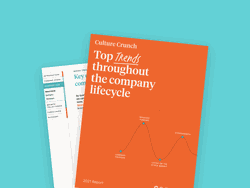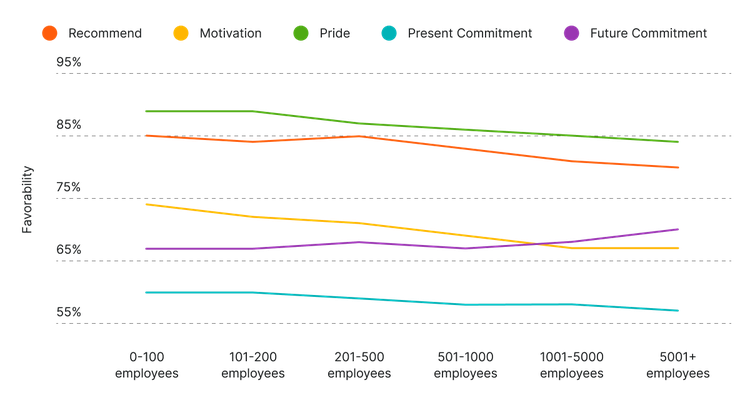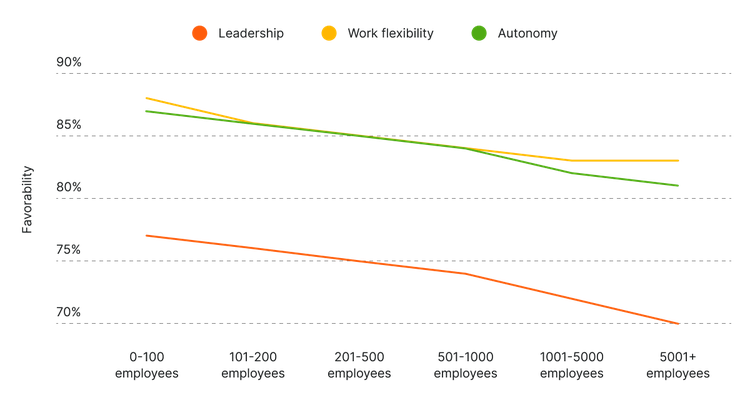
While growth is an exciting time for your company, there are common obstacles that can hinder your company’s development and success. Culture Amp’s latest company lifecycle report looked at the data from over 4,500 companies to better understand how companies of various sizes change during the growth process, including their biggest challenges. In this article, we’ll cover some of the business challenges that large companies face as they grow, along with tips to help your company overcome these obstacles.

Learn how to scale culture as you grow
The importance of investing in culture as you grow
Many founders and early employees prioritize company culture from the very beginning. Even at this early stage, companies recognize how laying out the foundation for the company’s mission and vision are key for successful growth. Arguably, the best way to lay out that foundation is by establishing core values.
Core company values are important to both employees and the company’s bottom line. When created and implemented thoughtfully, core values establish the company’s acceptable, expected, and celebrated behaviors. In other words, while the company mission explains what your company does, your company values define how your company achieves it. These values also guide decision-making and help navigate conflict. In that way, they’re more than just a foundation; they’re a compass for business and cultural growth.
Culture isn’t built overnight, however. And as your company grows, it becomes increasingly critical to success. When working in larger teams and organizations, individual employees can sometimes lose their sense of belonging, motivation, and purpose – which is where strong company culture comes in. In that sense, company culture matters most at large, enterprise organizations, despite its association with small startups.
Moreover, the data shows that investing in culture is worth it. According to PwC’s 2021 Global Culture Survey, which reports on 3,200 employees from more than 40 countries, strong cultures drive better business outcomes. Survey respondents who said they have a distinctive culture were:
- 48% more likely to see increases in revenue
- 80% more likely to see increases in employee satisfaction
- 89% more likely to see increases in customer satisfaction
In addition, 69% of senior leaders credit much of their success during the pandemic to culture, illustrating how company culture and strong core values can help companies successfully navigate unexpected challenges.
What to expect as your company grows
As a company grows in size, general trends emerge in the employee experience. As depicted below, responses to surveys measuring employee engagement are generally less favorable the larger the company is.

The report reveals that as a company gets larger:
- Employes are less likely to recommend their company
- Motivation decreases
- Employees feel less proud to work at their company
- Present commitment decreases, but
- Future commmitment increases
Looking at the data, it’s easy to see that engagement, in general, declines as a company grows. However, the last two points (present and future commitment) present an interesting paradox. Although employees at larger companies are more likely to be thinking about looking for another job, they are less likely to picture themselves acting on that thought. One possible explanation is that employees choose to join a larger organization for its stability.
While maintaining levels of employee engagement is difficult to do at scale, it’s not impossible. In the next section, we’ll look at the key challenges and areas of opportunity for large organizations looking to build better and more engaging company cultures.
Key challenges faced by large organizations
According to the data, large organizations face three key challenges as they grow. As illustrated in the chart below, sentiment around leadership, work flexibility, and autonomy significantly declines as companies grow larger. It follows then that large companies that get these three factors right can reap the benefits of a more engaged, motivated, and culturally-aligned workforce.

Challenge #1: Leadership
As leaders get further away, employees lose confidence and motivation
Culture Amp’s People Scientists found that employees’ perceptions of leadership decline as a company grows. The questions that relate more to an employee’s feelings about the company’s leaders, rather than leadership’s behavior, show even larger declines.
Specifically, the most significant declines can be seen in whether leadership’s vision motivates employees (5001+ companies are 9% points below <100 companies) and if employees have confidence in the leaders (-11%). The data suggests it’s increasingly difficult for employees to feel close to leadership in larger organizations.
Consider the following
Our previous research has shown that it’s rare to see any single factor have a more substantial and rapid impact on employee engagement than leadership perception. If employees feel disconnected from leadership, then there will likely be a substantial – even double-digit – decrease in employee engagement. As a company grows, leaders often become more preoccupied with the business. Many forget to make time to focus on connecting with their workforce – which is rapidly increasing in numbers – or on building on company culture. However, creating this connection is one of the most impactful things large organizations can do to boost motivation and confidence at a company.
Two of the most important tenets for leadership to embrace are authenticity and vulnerability. For example, including your employees in conversations through town halls or all-hands meetings will keep them updated on the business’s health and aware of what the leadership team is working through – creating that essential top-down connection that reconnects employees’ day-to-day responsibilities with the larger mission.
Challenge #2: Flexibility
Larger organizations provide less of the work flexibility that employees crave
Our report found that larger organizations are more traditional in how they expect work to get done and slower to adopt “new” ways of working – a trend we expect to persist in 2022. Accordingly, favorability towards the statement “We are genuinely supported if we choose to make use of flexible working arrangements” declines as a company grows.
There is also a similar trend in relation to the statement “I am able to arrange time out from work when I need to,” with 5001+ companies scoring 6% points below <100 companies. This is despite the fact there are more employees to cover a vacationing employee while they’re away, indicating this is an issue of mindset or company culture rather than resourcing. It’s also worth noting that large organizations were half as likely to ask these questions, which suggests that they might not see work flexibility and balance as essential parts of their employee experience.
Consider the following
In 2020, the pandemic caused most organizations to pivot to remote or hybrid work environments. As time went on and organizations became more acclimated to the new world of work, employees have begun to increasingly desire flexible work arrangements. As a matter of fact, lack of flexibility is one of the most significant factors in an employee's decision to leave a company during the Great Resignation. In that sense, building work flexibility into your company culture is not just essential for boosting engagement, but for reducing turnover and retaining your top talent.
However, it’s not enough to solely offer flexible work options – organizations must take a thoughtful, intentional approach when considering how to build flexibility and balance into their company culture. For example, remote and hybrid goal-setting is an essential best practice for making remote work more efficient. Alternatively, organizations can even consider the possibility of a 4-day work week, though this shift may be particularly challenging to make in a large organization.
Challenge #3: Autonomy
Employees in larger organizations have less autonomy
In our employee engagement surveys, we assess autonomy by asking people whether they agree with the following statement: “We have enough autonomy to perform our jobs effectively.” The data indicates that employees in larger organizations tend to have less autonomy over how their work gets done. One possible explanation could be that as roles become more specialized and more employees hold the same position, there is a more precise but rigid structure for finishing everyday tasks. There may also be more bureaucracy (and, on a positive note, direction) about what needs to get done and what can be deprioritized.
Consider the following
Employees at larger companies may be more comfortable with bureaucracy because they’ve come to expect it. However, employees still prefer autonomy. An HBR survey found that “bureaucratic drag” slows work down, wastes time, stifles innovation, and causes employees to focus too much on internal matters rather than on their customers – and that this problem is much worse in larger companies. Leaders at large organizations can address this by striving to eliminate unnecessary processes and fostering a sense of autonomy and ownership.
Setting achievable, aligned goals is a great way to move your organization forward and motivate your employees to succeed. Using objective and key results (OKRs) is one approach for providing a structured framework to guide and challenge your employees in the right ways through high-level objectives and key results that evaluate their success. By thoughtfully aligning individual and team goals to company-wide goals, leaders can ensure that employees recognize the value of their contributions, understand the metrics of success, and feel empowered to make decisions that align with the larger strategy.
Encourage managers to consistently check in with their direct reports through 1-on-1’s to see how they are progressing toward their goals. It’s also worth noting that goals may change as your organization’s business priorities shift. Revisiting your organization’s and employees’ goals quarterly will help your organization stay agile and efficient.
Overcome the challenges of growth
In smaller companies, company culture tends to develop organically. However, maintaining an engaging company culture often becomes challenging as companies grow larger. When cultivating a culture where your employees feel confident and motivated to work, it’s important to understand the key challenges that growing companies face. These challenges may be complex for large companies to address, but navigating change and scaling your company culture is worth the effort.
Leaders that get it right can unlock the benefits of a highly engaged and motivated workforce. Predict, prepare for, and overcome common obstacles with data-driven insights from Culture Amp’s latest report.





